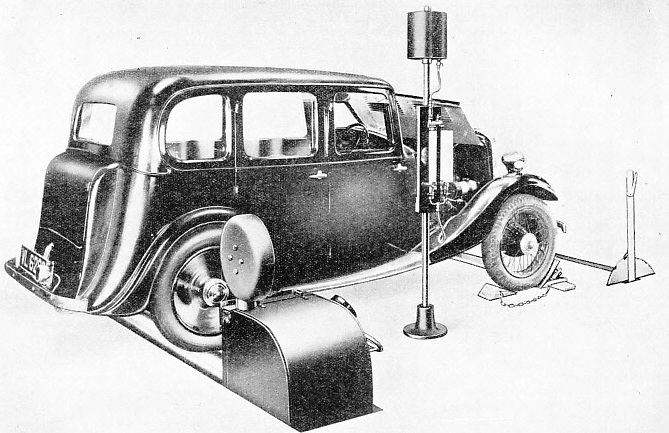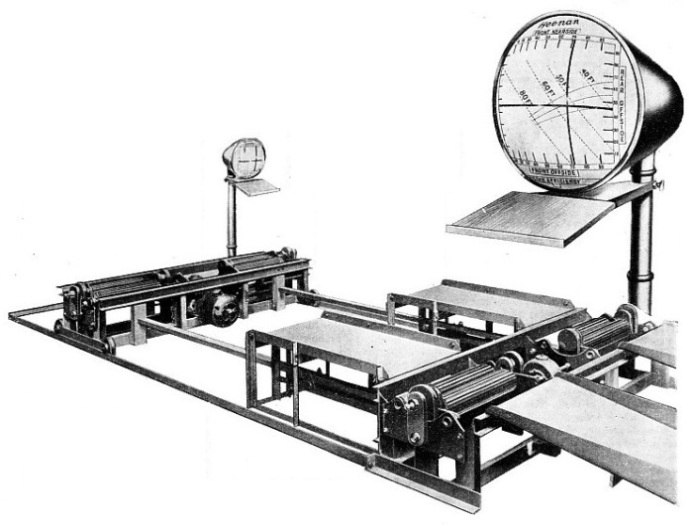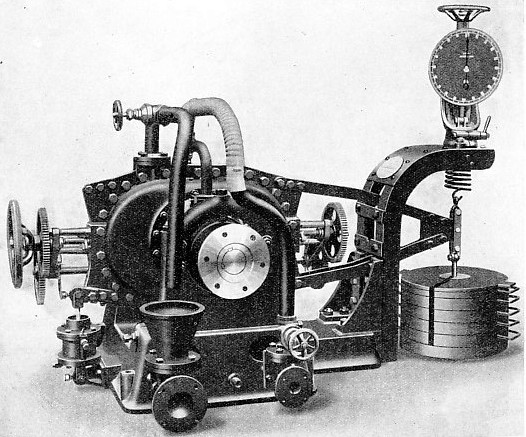


© Wonders of World Engineering 2014-


Machines of many types and advanced design are now being used by large garages to test the performance and braking power of cars, and to maintain cars in the best possible running order
A CAR PERFORMANCE TESTER, by which brake horse-power, fuel consumption and general performance may be checked after an overhaul. The tester consists of a drum carried in bearings on a framework and connected to a hydraulic brake. A variable load is applied to the car engine and a brake horse-power meter enables the exact power leaving the rear wheels to be read on a dial. The apparatus on the pedestal delivers measured quantities of petrol to the engine.
THE enormous development of motoring during the past few years has been responsible for a corresponding increase in the number of garages and service stations for maintaining the modern motor car in the best possible running order. As large-scale production has revolutionized the motor car industry, so it has been necessary for up-to-date service stations to equip themselves with the most modern and efficient apparatus for testing, repairing and maintaining the cars of their customers.
Some of this apparatus is familiar to almost every motorist. The hydraulic lifts on which a car is raised for a few feet while greasing and other operations are carried out are to be found at garages in every city and large town, and in many small country towns. Some of the more elaborate equipment, however, has not yet come into general use, and there are many ingenious machines of advanced design which may eventually be features of every large and well-equipped garage.
The effect of any major overhaul on the performance of a car is too often determined by haphazard methods. A road test will give a general impression of the performance of a car, but is generally too indefinite to satisfy a scientific mind. It is now possible, however, to drive the car up to a compact piece of apparatus, occupying little floor space, and to obtain direct readings of brake horse-power. The exact power leaving the rear wheels may be read directly on a dial. Fuel consumption and the accuracy of the speedometer may also be determined. Defects can be diagnosed and rectified in a fraction of the time occupied by a road test, and there will be no uncertainty about the efficacy of the cure. The entire series of tests takes only a few minutes from start to finish. This car tester consists of a strong drum, dynamically balanced to run safely up to high speeds. The drum is carried in bearings in a framework, and at the end of the shaft on which it is mounted there is fitted a hydraulic brake. This brake enables the load on the car engine to be adjusted at will, while it is running. The effect of level roads or steep hills may thus be simulated.
The whole apparatus is mounted in a pit with the main parts at floor level. The car to be tested is so placed that the rear wheels rest on a drum, and the front wheels are placed between chocks or held rigidly in some other way.
The hydraulic brake, which renders it easy to impose a variable load on the engine of the car, makes it possible to run-in an engine after an overhaul without the necessity for taking a car on the road. It is always desirable that part, at least, of the running-in process should be carried out with a load on the engine.
The hydraulic brake incorporated in this car tester is a modified version of the Froude hydraulic dynamometer, as used for testing high-speed internal combustion engines up to 2,000 horsepower. The full-size dynamometer places at the disposal of engineers a convenient means of measuring the power developed by prime movers of almost any size.
The dynamometer consists essentially of a rotor on a shaft running in a casing. The shaft is carried by bearings fixed in the casing — not in external supports — and the casing is carried by anti-friction trunnions so that it is free to swivel about the same axis as the main shaft. The engine on test is directly coupled to the main shaft, and transmits power to the rotor revolving within the casing, through which water is circulated to provide hydraulic resistance and also to carry away the heat developed.
In each face of the rotor are pockets or cups, divided from one another by oblique vanes. The internal faces of the casing are also arranged with a corresponding number of pockets and water is supplied to these pockets through holes in the vanes. It is discharged by the rotation of the rotor into the pockets in the casing, and a vortex action is set up, water being constantly circulated round each space formed by rotor and casing pockets.
The resistance offered by the water to rotation of the rotor reacts upon the casing, which tends to turn. This tendency is counteracted by a lever arm which ends in a weighing device consisting of a spring balance or a steelyard in combination with loose balance weights. Thus a direct reading of the power applied to the shaft may be obtained quickly and easily. The car performance tester is provided with a dial which gives direct readings of brake horse-power.
In Germany considerable use is made of an interesting portable car-testing plant which was designed to serve owners in the countryside and in small towns. The testing equipment is carried on a four-wheeled chassis which is hauled as a trailer, and the car to be tested is driven up on to the platform of this chassis on inclined ramps. The rear wheels rest on the drums of the tester, and the car secured in position by chains.
Car Vibrator
In this apparatus the drums are connected to an electric dynamometer, which measures the power output. An electric pendulum brake measures the tractive force. The electrical energy generated by the dynamometer is partly used to drive a large cooling fan, which is mounted in front of the radiator of the car in such a way as to simulate the normal flow of air which occurs when the car is travelling.
The testing of a car on this plant can be carried out in less than an hour, and the apparatus can be towed about the country at speeds of 30 miles an hour. Wagons weighing up to 16 tons can be dealt with by this portable which is in every way an ingenious piece of apparatus. Another unit which may be regarded as complementary to the car performance tester is a brake tester. Every owner driver knows that the accurate checking of the efficiencies of four brakes is an exceedingly difficult matter unless special apparatus is used. In its most general form, the brake tester comprises a ramp up which a car can be driven so that its wheels are in contact with a series of fluted rollers, electrically driven. The wheels of the car are rotated, separately or together, by these rollers, and the brakes are applied.
In one type of brake tester, four separate indicators register the amount of the braking effort on each wheel. In another there is a single large dial, illuminated from, within, over which four pointers move. The face of the dial incorporates a simple brake-testing chart, and it is possible to determine, at a single glance, the efficiency of each brake, the combined stopping distance, the correct distribution between front and rear brakes and the degree of safety on all kinds of road surfaces.
BRAKE-TESTING APPARATUS enables ideal distribution between front and rear wheel braking to be obtained. The fluted rollers are rotated by electrical means, and they drive the wheels of a car mounted on the apparatus. When the brakes of the car are applied, direct readings of their efficiencies are given on the dial (shown in greater detail illustration on the right). The tester makes it possible for all four to be adjusted so that their combined effect enables the car to pull up in the shortest possible distance.
The mechanical process used in these testers is the converse of that which is applied in the car performance tester. Instead of imposing a resistance on the driving power of the engine, the car is made to apply a resistance — by its brakes — to a known driving force. Six-wheels brake testers for public service vehicles to a laden capacity of 20 tons are built.
An ingenious and un usual piece of apparatus, which is not yet found in many garages, but which is used in the shops of several well-known manufacturers, is known as a car vibrator. This takes the form of a spring-mounted platform, on to which the front or rear wheels of the car can be driven. The platform is rocked by an electrically-driven shaft carrying out-of-balance weights.
Its purpose is to make it possible to locate the squeaks, rattles and drumming of body, springs or chassis which are often so annoying to the car-owner and so elusive to the garage mechanic. The vibrator reproduces faithfully the conditions encountered on a poor road surface, and as the work of rectification can often be carried out while the car is being vibrated, it is possible to determine at once whether the cure has been effective.
Yet another service that can be carried out on the floor of the modern garage is the testing of speedometers for accuracy. This is an important matter in these days of built-up areas and speed limits of 30 miles an hour, but the principle of the speedometer tester is extremely simple, and the apparatus is compact.
The rear of the car is jacked up, and the rear wheels make frictional contact with a pair of rotating drums on a shaft. At the end of this shaft is a small generator, whose voltage output is proportional to the speed at which it is rotated.
Thus it is necessary only to couple this to a voltmeter, the dial of which, however, is directly calibrated in miles an hour, to obtain a direct reading of speed. The owner-driver can thus sit in his own car and “rev up” the engine, with top gear engaged, to any
speed. Without moving from his seat he can compare the reading of the speedometer on the instrument board with the large dial of the special speedometer coupled to the tester.
The attractive feature of each apparatus is that it makes it possible to carry out, in a garage, tests that would normally occupy a considerable amount of time on the road. Performance tests, brake tests, searches for rattles and squeaks, and speedometer testing must have been responsible for an enormous waste of time in the past, particularly in the days of checking speedometers against milestones with a stopwatch.
“Lubrication -Batteries”
Other equipment for washing and lubrication is now of extremely interesting design. One field in which a great advance has been made is that of high-pressure lubrication of spring shackles, springs and nipples on various moving parts.
One type of air-operated power gun works with an air pressure of 80 lb. to 200 lb. per sq. in., and it is claimed to develop a lubricant pressure thirty times greater than this. It is equipped with a hose tested at 20,000 lb. per sq. In.
Portable electric tyre inflators — sometimes combined with high-pressure lubricators — are another comparatively recent innovation. Such a unit consists of a small air compressor with a storage tank, and a high pressure drum pump.
Some of the larger service stations are equipped with “lubrication batteries”, with drums of grease lubricant and bulk containers of gear oil, synchromesh oil and extreme pressure oil mounted on a platform.
The contents of these drums are dispensed without the need for transference into special containers, and some models are provided with automatic hose reels. The nozzles of the hoses project from the sides of the unit, but the hoses disappear through the front panel into sheet steel housings, where they are kept clean and free from kinks. The control panel is provided with separate oil meters for each delivery, an air-pressure gauge, shut-off valves for each delivery, and control valves for a hydraulic lift.
The hydraulic car lifts — perhaps the most familiar of all these labour-saving devices — are generally operated by air compressors, the load being supplied by a column of oil. A supply of compressed air at a maximum of 150 lb. per sq. in. will lift a-weight of up to 3½ tons. The principle employed is that of the ordinary hydraulic ram.
There is, nowadays, every inducement to motorists to leave the responsibility of keeping their cars roadworthy in the charge of qualified garage.
A HYDRAULIC DYNAMOMETER which can be used for testing high-speed internal combustion engines up to 2,000 brake horse-power. An engine on test is coupled to the main shaft and transmits power to a rotor within the casing. Resistance offered by water makes the casing tend to turn, and its pull on a lever arm is measured directly by the weighing device on the right.
[From part 27, published 31 August 1937]
You can read more on “Modern Traffic Control”, “Romance of Motor Car Making”
and “Story of the Motor Car”
on this website.




